***SPOILER ALERT***
If you want to do the Fictional Female Sleuths puzzle before I talk about how I constructed it, stop right now and go to the puzzle page then come back here and read about it.
All constructors—even me—start by deciding on a theme. Admittedly, I don’t have to do this very much because the “themes” for my puzzles in the Crossword Mysteries are always clues from the actual book itself, whatever Quinn wants to subliminally plant for the chief of police.
Here’s an example of a more elaborate theme.

LIFEBOAT, BOATSHOW, SHOWDOWN, DOWNPLAY, etc
But for our purposes today, let’s say my theme will be Fictional Female Detectives. It’s not a very complex idea, but I’m not a very complex constructor.
I start by brainstorming a list of sleuths. Then I go back and count the letters for each entry.
I cross off the 16s because they won’t fit in my 15×15 grid. *taps temple to show I’m a thinker* I cross off the 13s because those are almost impossible to work with because of the symmetry of the puzzle. I cross off the 9s because they’re a little short and probably won’t stand out as theme entries. I cross off the lone 10 because I don’t have a mate for it. (I could keep brainstorming to find another 10-letter sleuth, but I have plenty of 12s.)
- Jane Marple (10)
- Nancy Drew (9)
- Aurora Teagarden (15)
- Kinsey Milhone (13)
- Trixie Belden (12)
- Vera Stanhope (12)
- Precious Ramotswe (16)
- Stephanie Plum (13)
- Jessica Fletcher (15)
- Veronica Mars (12)
- Clarice Starling (15)
- Phryne Fisher (12)
- Quinn Carr (9)
- Charlemagne Russo (16)
I’m looking for symmetrical lengths. In my relatively easy puzzles, I can have one 15-letter entry right in the center. But I’m looking at those four 12s and digging on them. I won’t use a 15, just the 12s.
So here’s my final list:
- Phryne Fisher (12)
- Trixie Belden (12)
- Veronica Mars (12)
- Vera Stanhope (12)
Now I open up a new grid in my Crossfire program and place these four theme entries. I place black squares at the end of PHRYNE FISHER and the program automatically places the corresponding three black squares to maintain symmetry. That’s where I type in TRIXIE BELDEN. Then I do the same with the other two entries.
There’s absolutely no reason why I placed these where I did. It’s just a starting point. More experienced constructors can probably realize the potential pitfalls of placement before typing them in.
“Potential Pitfalls of Placement.” That’s going to be the title of my crossword constructor memoir – ha!
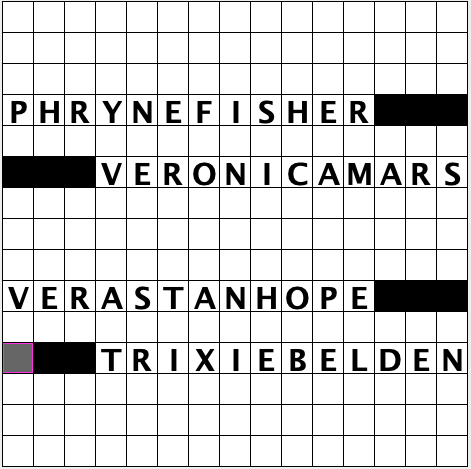
Now I try to figure out how to block off long spaces to make more manageable entries. This is absolutely trial-and-error—and tons of time—to get it where I’m happy. This is also where I can move the themes to different locations to see if they’d work better elsewhere.

I picture which letters would end a word better. For instance, I put a spacer between the Y in PHRYNE and the V in VERONICA because I’d rather end a word in Y and begin one with V. My program tells me there are 431 words that end with Y that could fit there.
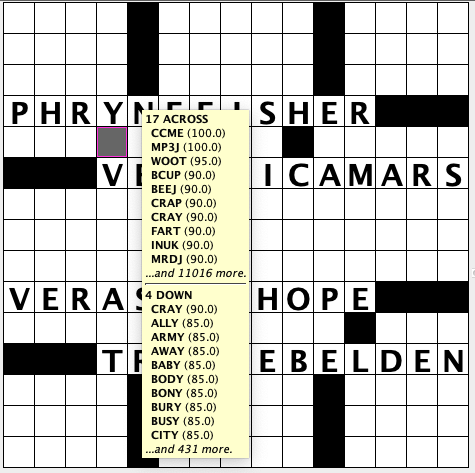
But if I move that black square below the V, I see there are only three possibilities for entries there. And they’re all bad, so I move the black square back where it was. Longer words are often more interesting, but not when they end in V!
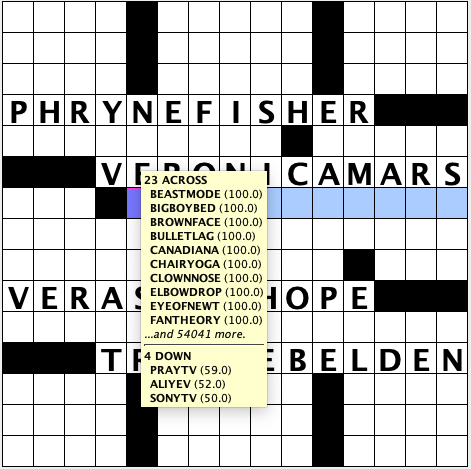
When I place my black squares I also have to be conscious of not making 2-letter words (which my program alerts me to), not having too many 3-letter words, and trying to keep to a maximum of 38 black squares.
This is the hardest and most frustrating part for me. I’ll keep track of the time and tell you how long it took to get a grid I’m happy with. The frustration comes in when I think I have a workable grid, but halfway through filling it with entries, I realize I’ve painted myself into some impossible situation and have to start over.
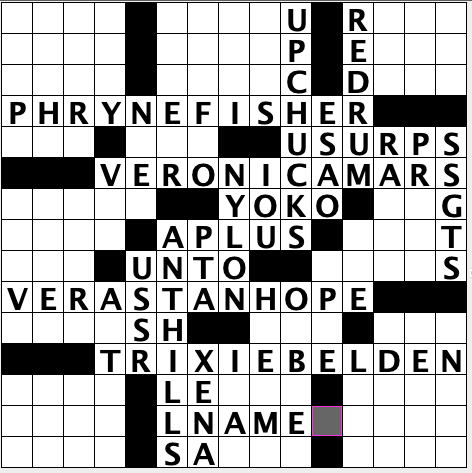
This took me 30 minutes. I started filling the grid before I really studied the grid. Rookie mistake. (And one I keep making. Sigh.) After I did all this, I saw the X in Trixie. Uh oh. Walk away, Becky. Just walk away.
After another 30 minutes the next day, I finally had to concede defeat, giving up on that grid. I moved my theme entries around. If I still have trouble, I can add a black square between the T in STANHOPE and the R in PHRYNE, which will also put a black square between the D in BELDEN and the C in VERONICA. The standard is to have no more than twenty 3-letter words, and by adding them, it would only bring me up to eighteen. But to lose my only 8-letter words would make me sad. Not sad enough not to do it if my frustration level threatens to smother me, mind you.
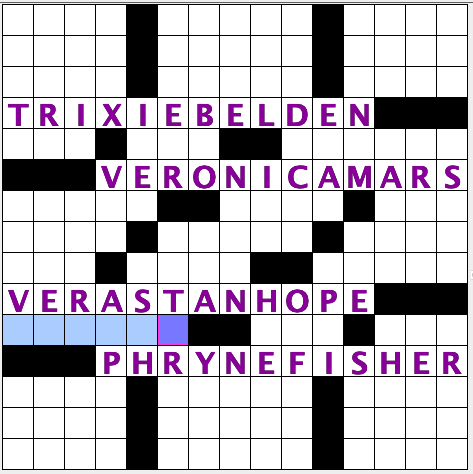
I could have gone back to my list of sleuths and chosen a 15-letter entry for the center of the puzzle, and just two of the 12-letter ones. But I chose to start over with the same four sleuths. This time, however, I decided on that X first thing. I probably shouldn’t have used TRIX and TRIXIE, but I really wanted a “silly rabbit” clue. There are many ways to fill that corner, so I’m not worried about the rest of it. But I am worried about that P in STANHOPE and that I in FISHER. OPTI is my only, ahem, option there. So I’m going to concentrate on this section to make sure I can get it to work.
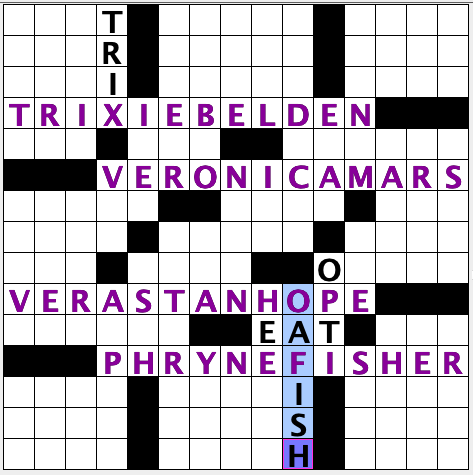
One hour and twenty-one minutes later. Frustrated. Had a snack. Came back. Switched my themers up. Twenty minutes later had this:

Back in the bad old days, constructors used pencil and graph paper to make puzzles. For fun [spoiler alert: it was decidedly not fun], I tried creating a puzzle by hand. How hard could it be, I scoffed. My conclusion was that it can be done—in the same way a novel can be written on a scroll of single-ply toilet paper—just not by me.
My computer program is robust. I’ve added a couple of dictionaries compiled by generous, more established constructors, so this is what I see when I’m attempting the fill.
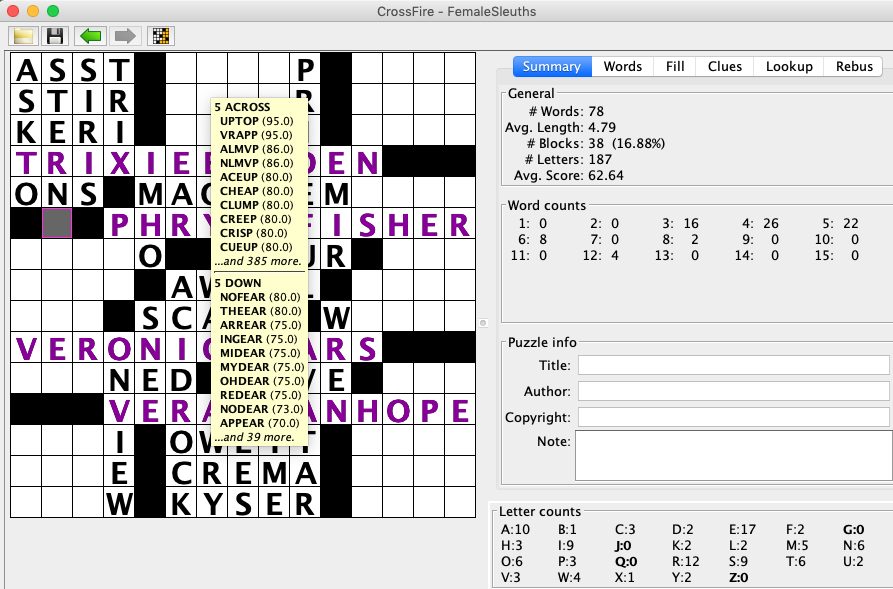
When I plant my cursor in the 5-Across/Down square, if I ask it to, it tells me all the possible words I can use. You’ll see there’s a score next to each word. The higher the number, the more that constructor/dictionary creator likes that word. There’s a big push these days to make puzzles more inclusive and up-to-date, using more words that will appeal to a broader swath of people. I don’t care much about my scores, though, because I’m not submitting my puzzles for publication anywhere but my books and website.
I use the list of potential words as my springboard. As I’m checking the viability of my grid, I’m hovering over the squares, making sure there’s a healthy list of words I can use. Earlier, when I painted myself in the corner with that X in TRIXIE, it’s because I failed to do this. I just got distracted by the cool fill elsewhere.
And then it’s just trial and error and choosing words that please me. It broke my heart when I had to give up on that grid earlier because I was going to use REDRUM in there. How awesome is that?? Now to my dying day I’ll be looking for a way to get REDRUM into a puzzle.
You can also see the rest of the page I get as I work. It shows me how many words and black squares in my puzzle. Because I’m such a novice, I’m stepping a bit over the maximum number of blocks (40 instead of 38), and I’m at the max for number of words (78). It also shows me how many of each letter of the alphabet I’ve used. I try to use at least one of everything, but that’s not a deal-breaker for me. I’m just worried about getting a solid fill. I’ve heard more experienced constructors say it’s perfectly fine to bend the rules to get a better puzzle, so I’ve taken that advice to heart. It has saved my sanity plenty of times.
It’s been another two hours and I finally got the upper center section filled. But I’m not happy with it because it has what’s known in the crossword biz as some “dirty double crossers.” All three of those red boxes are obscure proper names, so you’d have to know them in order to solve the puzzle. You could maybe get them elsewhere in the puzzle if you didn’t actually know the person, but not when they all cross like that.
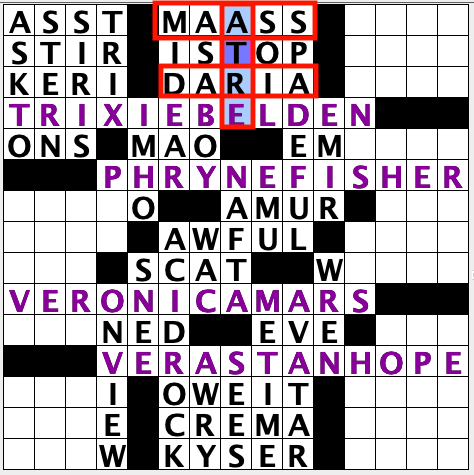
So my decision here is to keep trying or undo SPADEFUL and everything that entails.
The hard part about sticking with it, is that MAO can be MEL or MAL or MEN or MAN or MEA or MIA … which means MIDEAR and ASABOY can change in myriad ways. And SPADEFUL can be PRIDEFUL, so the combinations are complicated. It’s like scientific testing. You try to only change one variable at a time, but here, every variable you change has ramifications you can see immediately.
But I’ve spent all morning on this, so I’m going to have my lunch.
Twenty minutes after lunch I had this.
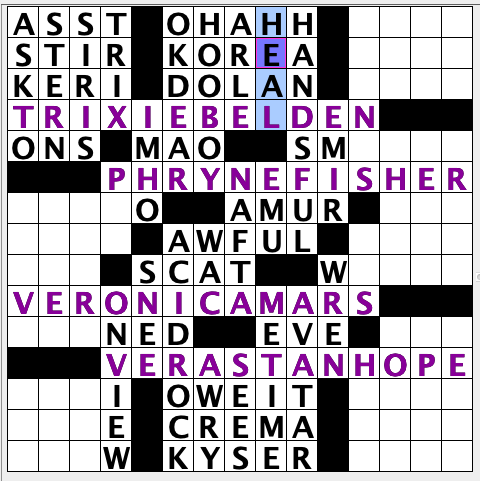
Still not completely happy with it, but it’s much better than before. There’s no way I’d submit this to the NYT, but for my purposes I can make it work. Onward.
It took me forty-five minutes to finish the rest of the entries.
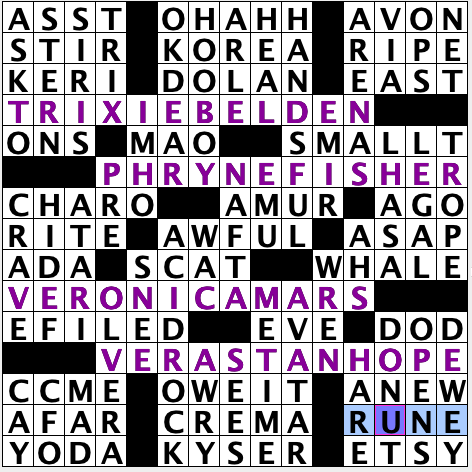
It’s not the best puzzle I’ve made, but it is the best one I can make with this grid and these theme entries.
Now comes the fun part … writing the clues. When I’m filling the grid, I often choose words based on a cool clue that pops into my head. That’s why SMALLT and CCME and METIME are in this puzzle. And TRIX.
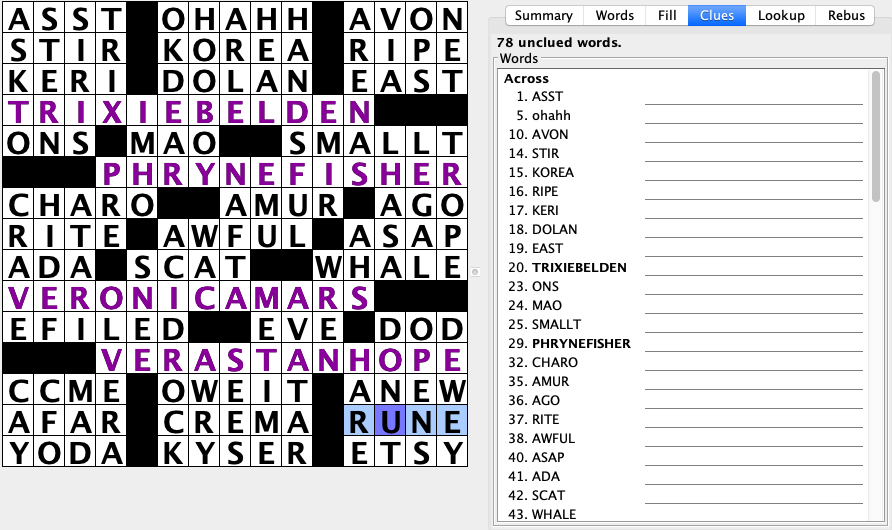
Writing the clues is just as it sounds. I type them right in that space, making sure I capitalize properly, abbreviate as necessary, spell correctly, fact check, have usage agreement between the clue and the entry (if the entry ends in ED, then my clue better be past tense, for instance), and I have to consider the difficulty of the puzzle. I try to keep mine in the middle somewhere—not too easy for experienced puzzlers, but not too hard for novices. I rely on my testers to tell me if I hit the mark or made any mistakes. They’re like the beta readers for my novels. I think this one is kind of on the more difficult side, though.
Unfortunately for me, sometimes I find problems when I’m cluing. In Fatal Solutions, book #3 in the Crossword series, I was caught in the crosshairs of a deadline. I can’t make the puzzles for the books until the books are finalized in case pertinent facts or suspects’ names change. So I was working like mad to get a good puzzle to my editor before my deadline and was so thrilled when I realized it would happen. Until I was cluing, that is, and realized I’d used the word TRADE twice in the puzzle! That would never fly in the professional world of puzzles, but in my books I get to do whatever I want (remember, my sleuth Quinn is actually the constructor so I rely on her good judgment). Quinn told me to relax and keep them both, just write funny clues for them. So I clued one as “swap,” and the other as “if you swap this for 54-Down, you get the same thing!” It made my testers laugh, so that was good enough for me. Who needs a bunch of humorless automatons working my puzzles??
After I get feedback from my testers, I make whatever tweaks they point out, and then I stick a fork in it because it is DONE.
So that’s all there is to it! Makes you want to start constructing, I bet ….
How’d you do on the Fiction Female Sleuth puzzle? Did you find it easy? Hard? In between? Did you find any mistakes?